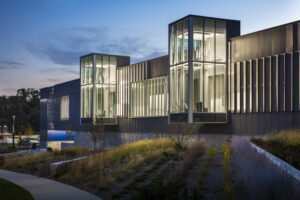The Final Piece: The Nebraska State Capitol Courtyard Fountains
Its plan was ingenious in that it was built around the then-current and crumbling Capitol, which was in service until the outer ring of the…

Biophilia is humankind’s inherent connection with nature and explains why ocean views, mountain hikes, gardening, daylight, and parks restore our mind, body, and spirit. Building design inherently impacts human health and wellness and the inclusion of biophilic design concepts in our buildings supports positive health outcomes. Pulling aspects of the natural environment indoors and integrating biodiverse outdoor amenities (features) are ways to achieve a biophilic design.
Literature from many sources including the Living Futures Institute outline various approaches to biophilic design. Below are fifteen patterns outlined by Terrapin Bright Green in 2014 for biophilic design.
Several projects at BVH incorporate these patterns. Specifically, one project that achieved success and earned a LEEDv4 Innovation and Design credit for biophilia, was the Metro Community College (MCC) Automotive Technology Facility. MCC Auto Tech’s use of biophilia incorporates eight patterns of the fifteen listed above, in the design of this cutting edge technology education facility. Images below were used to highlight the biophilic patterns for the LEED innovation credit.
Exterior glazing provides a visual connection with nature through nooks projected into a native landscape. Nature in the space is further enhanced through the use of skylights and clerestories connecting humans to the dynamic patterns and diffusing daylight. Through the nooks and exterior glazing the surrounding landscape connects people to natural systems showcasing the seasonal variability of native plantings and weather patterns.

Wood materials and wall coverings introduce biomorphic forms and patterns similar to what exists in nature. Acoustical ceiling elements are used throughout the building referencing natural organic arrangements. Glass bridges throughout the space are decorated with glass film patterned to mimic clouds.

Natural analogues of complexity and order occur within the biomorphic forms and patterns across the ceilings, cloud patterns, and a nature inspired color palette. Additionally, the exposed structure and MEP systems showcase manmade layers of order and complexity within the spaces.
Views across the space take in the entire building from one end to the other creating a feeling of prospect. Further facilitated through the transparency and openness in the space.

Refuge is provided in small seating areas and private conference rooms alongside the nooks providing a sense of protection for occupants.
The biophilic element of risk/peril is experienced through the protected walkways overlooking the education spaces below, glass railings overlooking two story spaces and cantilevered nooks at the exterior of the facility. Providing a sense of excitement while still maintaining the feeling of security.
Biophilic design operates over scales from touchable close materials, to the whole building organization and layout. All occupants benefit from biophilic elements and experiences of nature throughout the building. Building on our experience, BVH will continue to prioritize health and wellness through design excellence.
